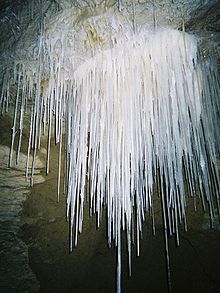@Weird Tolkienish Figure It is a shame about those men, and a tragic story. I don't think recklessly stupid fits, but they should have taken the weather into consideration. How many hikers have been killed in flash floods (and still get killed), or climbers/skiers in avalanches, even though we understand the phenomena far better now?
I understand that drive to explore farther. It's addicting.
That's a dry passage in the video, and those aren't as bad as they look. That dust he's crawling through usually makes either a very sticky or a very slippery mud, depending on the amount of water present. Either can be a pain, depending on the geometry of the passage, or no real bother at all if dry (just dust or like packed dirt), but the clay will permanently stain whatever you are wearing.
If you are in decent shape, the average guy can wiggle through a hole no bigger in cross section than the area of a cafeteria lunch tray.
I have been through slightly tighter tubes, but they were shorter (the 'connection' between Sinnett and Thorn Mountain Caves in WVa
http://www.psc-cavers.org/stcc/Sinnett-ThornImages.html, now a National Natural Landmark) and the room I had left was 900+ ft. long, the mudslide I eventually came out on, I don't know how long but at steeper than 45 degrees. I just know you kept moving up or you were moving down, at least until you got to the ledge you had to swing up onto to climb to the Throne Room in Thorn Mountain.
That was over 40 years ago, and I would not make it through there now.
A small group of us entered quite a few caves in the Shenandoah Valley and over in West Virginia when we were undergrads. We were not the only group, by a longshot. It was fun, challenging, and though by modern standards we'd likely have been considered cavalier in our approach, we were careful to check weather info, and to make sure our equipment was in good order so we would avoid problems. We used carbide lamps, carried carbide in film cans in WWII surplus M1 Garand ammo belts (The belts were 2 bucks at the surplus store, worth a comparative fortune now), and could rebuild our carbide lamps in the dark--and did on a couple of occasions. Spent carbide was carried out in plastic bags in surplus gas mask pouches, which everyone seemed to have. (To this day, I still use surplus gear for other things, it holds up well). One canteen for drinking, one for the lamp. On occasion, someone even thought to bring a camera.
Risk assessment and preparation are your friends where the dark is more dark than anything on the surface.
Usually, when people had been there recently, there were knee or footprints, but occasionally, there were small side passages with no signs of prior human presence. It was a chance to go where no one had gone before. (Take that, Captain Kirk!)
The real fear, as the article says, is getting caught in what amounts to a flash flood in an underground river like that crew did. (Yes, area weather reports matter). Frankly, we avoided that.
Getting buried in a cave-in seems like a hazard (most notably, Floyd Collins in Crystal Cave), but we weren't there to remodel the place, so the rock was pretty stable.
In fact, unlike the massive columns and flowstone, the finer speleothems are actually quite fragile, as are the bats who may live there.
https://en.wikipedia.org/wiki/Speleothem Links in the text where different types are described go to better descriptions of the individual types with photos. Beauty like this

just can't be seen on the surface; specimens may only be legally removed by permit and fines are steep, but doing so illegally would guarantee the violator would be shunned by the caving community.
The only cure for the caving 'bug' is to move into an area with no caves. Withdrawals are complete after a few years and growing out a couple of belt notches...
